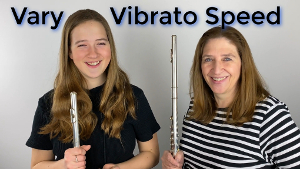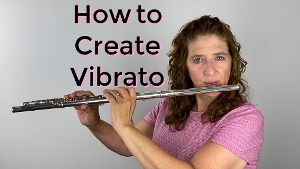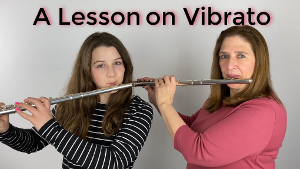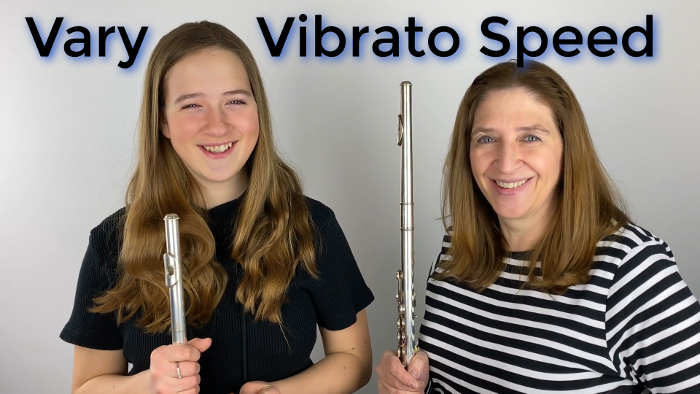Vibrato is something that all flute players use in their flute tone. But too many have one vibrato and use it for every piece they play. In reality, vibrato is a tool to be used to create color for each piece you play. Vibrato speed is one way to create different colors.
Now, vibrato is one of those things that, for a lot of people, once it gets turned on, it does not ever change – not ever! This is not how we should approach vibrato. It should never remain the same for everything. Vibrato should vary to suit the style of the piece we are playing. Not every piece is set in the same style and thus one vibrato does not work for every piece.
Use Vibrato as a Color
When vibrato changes in speed it colors our tone. A faster vibrato can make a sound more intense. A slower vibrato can help bring out a woodier tone. Use vibrato as a color. It then becomes a new tool in the basket of different sounds and colors.
In this video, I have my daughter Allegra demonstrate how to change her vibrato. She has a good “default” vibrato. Our default vibrato is the one that just happens when we put the flute to our lips. But her vibrato is very much the same in everything she plays.
Good Tone is Essential
Before she begins, I have her play the first note in the Fauré Fantasie. I notice that she needs to adjust her embouchure as she has rolled in too much. But then because I have her roll out, the high B fights to go low instead of high. A good tone is essential to working on vibrato. If you do not have a good tone first, no one will care that your vibrato varies. To make the note not fight for the low register, I have her raise her upper lip and use more air pressure. If these two things are good, then the tone will be good. When she has her tone sounding nice, then she re-plays that high B at the beginning of the Fauré Fantasie.
When you listen to the video, you will hear that she plays with a nice vibrato, with a nice speed. It’s not too deep. It’s not too slow. It’s not too fast. It’s a good default vibrato. We all need to have our default vibrato. But that default vibrato, the one you always start with must vary. You must learn to vary it.
Speed Up Your Default Vibrato
I like to begin the Fauré Fantasie with a medium vibrato. I think it works very well. But it does not have to be that vibrato. What if we wanted a more intense opening? Could that vibrato move faster? When you are working with this long opening B, let yourself explore different tone colors with different speeds of vibrato. It really helps you to figure out what you like best. If you only ever play vibrato one way, then how do you know it is the best one for the piece?
When speeding up your vibrato, it should feel slightly different. I have my student works with this faster vibrato and try to describe if they think the vibrato physically moved inside them. For me I feel that the vibrato moves more forward. I do not want to say it is a forward vibrato but that it moves slightly forward to speed up. Try it yourself. Does it feel different when you speed it up?
Learn to Vary Vibrato
Now let’s take a look at the Allegro in the Fantasie. Because of the much faster tempo, the vibrato absolutely must speed up. The sound waves are moving faster, so a slower vibrato would not settle into the sound waves. The faster vibrato fits into the wave and does not hit the top of the wave like a speed boat thumping up and down on ocean waves.
How about a different style of vibrato such as one we would use when playing Baroque? My default vibrato will not work because it is too present. I need a vibrato that recedes into the music. I do not want it to stand out and be prominent. I want Baroque vibrato to not be too discernible. One of my teachers called it back vibrato. To do this vibrato, I slow it down and open up my embouchure to make the tone a little less bright more on the woody side, and I move the vibrato back.
Can you do that? Try it out and see what affect you create. Make it a very gentle vibrato.
Sopranos Call it Spin
Sometimes we stop talking about vibrato and start using the word spin. Sopranos use this term for their vibrato as they are in such a high tessitura. We flute players use that term when we must play high short tones. If you think of the word spin on a high short tone, then what comes out is a resonant high note that is alive. I have my student try this on the video and I think she is successful.
The bottom line is that you must be in control of your vibrato. Too many people are not in control. When they put the flute up, they use the vibrato that comes out – their default vibrato. There’s many a pop singer that only ever uses this default vibrato, because they have not learned how to change it for the song they are singing. So, they can only use the vibrato that comes naturally to them – their default vibrato.
The Bottom Line is Control
I think a mark of a true musician is that you can vary your vibrato speed. It is something that you learn to manipulate to add to the tone color of a piece that you’re playing and/or singing. So now I want you to think about your vibrato and not to just use the same one all the time. Instead, you should think about the piece you are working on and decide whether it needs a faster or slower vibrato. When you play a more modern piece, or a Baroque piece, decide which vibrato is appropriate for those pieces.
Vary your vibrato. Change it up. Show that your vibrato does not have to stay the same all the time.
Have fun working on your vibrato!
DoctorFlute
Watch me demonstrate this:
Varying Your Vibrato with Speed Lesson with 14-Year-Old Student Allegra – FluteTips 124

How to Create Vibrato on the Flute – FluteTips 109

Live Flute Lesson on Vibrato with 12-Year-Old Student Waverly – FluteTips 122
Watch me as I teach my 12-year-old daughter in real-time how to play with vibrato:

